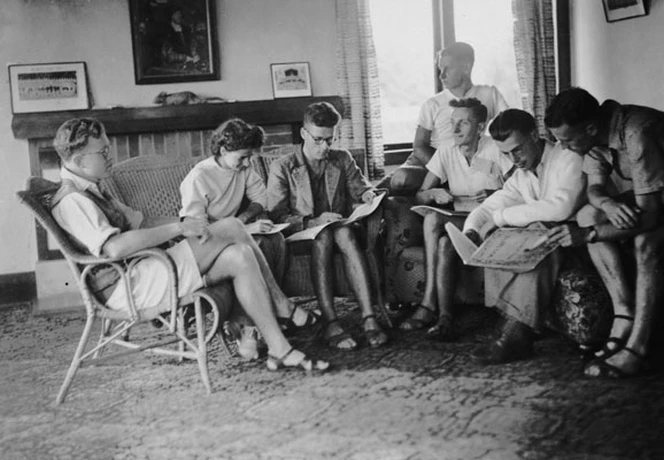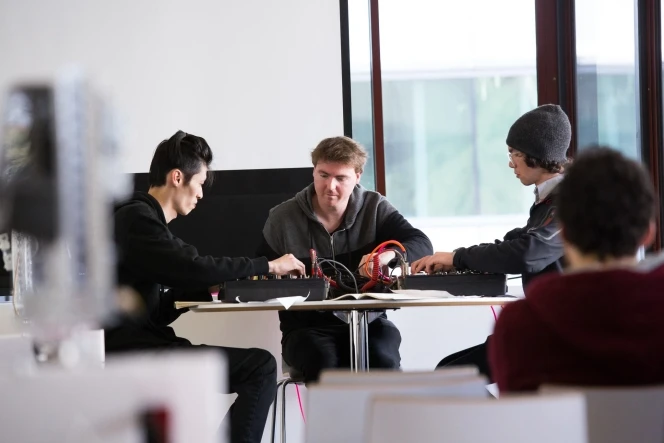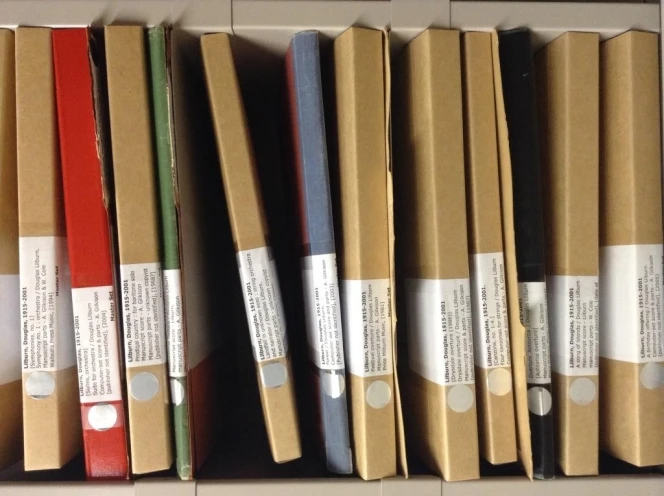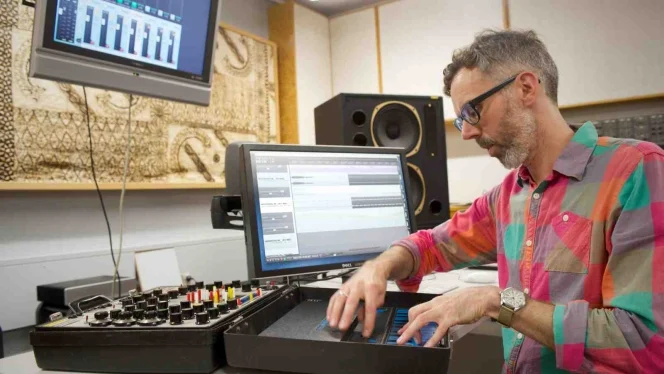Centennial offerings
The centenary of New Zealand composer Douglas Lilburn’s birth has been marked this year with concerts, new recordings and editions of his works, conferences, and much more. The Alexander Turnbull Library, guardian of Lilburn’s scores and papers, has had the privilege of contributing to many of these “Lilburn 100” tributes and initiating several ourselves.
This blog takes you on a whistle-stop tour of Lilburn centennial offerings from the past twelve months. If the concerts and other events passed you by, then numerous interviews, reviews, photographs, and other gems still remain accessible online (links to these are included below).

Photo by Chris Black of Douglas Lilburn (1960s). Ref: PAColl-7737-3-01
The father of New Zealand art music
Douglas Gordon Lilburn (1915-2001) is often referred to as the “father” or – increasingly of late – “grandfather” of New Zealand composition. There were notable local composers before him of course, such as Alfred Hill, but these epithets are recognition that Lilburn founded a composing tradition that continues through to the present day.
Lilburn’s legacy is wide-ranging. His compositions, encompassing works for orchestral, piano, and chamber ensembles, song cycles and electroacoustic recordings, are still often performed. His ideas about New Zealand music – as laid down in the manifestos A Search for Tradition (1946) and A Search for a Language (1969) – continue to ignite debates about cultural identity in music. The Lilburn Trust makes a substantial annual contribution to the art music sector.

Composers’ class, Cambridge Summer School of Music (1948). L-R: Douglas Lilburn, Dorothea Franchi, Carraigh Thompson, Edwin Carr, Larry Pruden, David Farquhar, Ronald Tremain. Copyright Alexander Turnbull Library, all rights reserved. Ref: PAColl-2547-16
Lilburn also exerted considerable influence as a teacher, both at the Cambridge Summer Schools of Music where he was composer-in-residence from 1946 to 1949 and 1951 to 1953, and as a lecturer at the School of Music at Victoria University from 1947 until his 1980 retirement. Among the many young composers he encouraged were Ronald Tremain, Dorothea Franchi, Edwin Carr, Larry Pruden, and David Farquhar; later protégés included Jack Body, Ross Harris, and Martin Lodge. Several followed Lilburn into university teaching, thereby transmitting something of his creative ideals to new generations.
In 2014, Lilburn was posthumously inducted into the New Zealand Music Hall of Fame. He remains the only composer to be so honoured thus far.
Lilburn at the Library
The Alexander Turnbull Library has many reasons of its own to celebrate the 100th anniversary of Lilburn’s birth, including the composer’s suggestion that the Archive of New Zealand Music be established here and his many donations of scores, papers, and recordings. One way we have chosen to celebrate the Lilburn centennial – as Keith McEwing describes in his blog ‘Happy birthday Douglas!’ – is to commence a major project to digitise Lilburn’s unpublished recordings and manuscript scores.


Top image: Jon He, Jason Long, Jim Murphy. Bottom image: Bridget Johnson’s mechatronic speaker system. Photos by Mark Beatty.
Throughout the year there were events and publications at the Library to mark Lilburn’s contribution to New Zealand music. Over winter, we hosted the ‘Lilburn for lunch’ series of weekly concerts in conjunction with staff and students of the New Zealand School of Music (NZSM). Starting with Lucy Gijsbers (cello) and Andrew Atkins (piano) performing selected Lilburn pieces on 18 June, the series concluded with three concerts in which Sonic Arts students responded to his electroacoustic work by filling the Library’s ground floor with strange and wonderful sounds of their own.
The annual Lilburn Lecture on 4 November, meanwhile, provided an opportunity for Chris Bourke (current Lilburn Research Fellow) to reflect on Lilburn’s creative manifestos and to ask if local popular music provided its own basis for national identity.

The cover of this year’s Turnbull Library Record featuring Leo Bensemann’s 1942 portrait of Douglas Lilburn. Ref: G-264.
Douglas Lilburn was also commemorated in this year’s Turnbull Library Record. Resplendent with its cover portrait of the young composer by Leo Bensemann, the journal issue contains articles on a range of New Zealand music topics, penned mainly by Turnbull Library music specialists. Also featured is Lilburn biographer Philip Norman’s fascinating discussion of the sometimes-fraught correspondence between the composer and his UK publisher Max Hinrichson.
Concerts near and far
Lilburn’s music has been heard far and wide this year. The website of SOUNZ Centre for New Zealand Music lists over 50 concerts including Lilburn works from around the country during 2015. A number of overseas concerts have also featured Lilburn works.

A few of the many Douglas Lilburn scores in the Orchestral Music Hire collection. Photo by Matt Steindl.
On 30 May in London, New Zealanders Christopher Bowen (tenor) and Lindy Tennent-Brown (piano) performed the Sings Harry song cycle at the Australia & New Zealand Festival of Literature & Arts. With other overseas concerts, the National Library of New Zealand contributed directly through its Orchestral Music Hire Service (the Library being the hire agent for Lilburn’s orchestral works). Events utilising our scores included the following:
The BBC Philharmonic gave two studio concerts in Salford with works by Lilburn: the first concert on 1 April to mark Anzac Day was conducted by New Zealander Tecwyn Evans and featured Symphony no.2; while the second concert on 8 September included Drysdale Overture and Forest.
The Ulster Orchestra under the baton of Nicholas Braithwaite (son of renowned New Zealand conductor Warwick Braithwaite) performed A Song of Islands at its 21 August concert in Belfast.
The Australian Youth Orchestra performed Diversions for Strings at an Adelaide concert on 17 January (review in The Advertiser).
In Sydney, the Beecroft Orchestra performed Aotearoa Overture as part of its 29 March concert.
And if you happen to be in New Jersey around 30 January next year, then check out Sinfionetta Nova’s winter concert where they will perform Aotearoa Overture.
Closer to home, the National Library provided Lilburn orchestral sets to some twenty different ensembles over the last year. These included concerts by many of our larger orchestras:
Christchurch Symphony Orchestra, 21 March (reviewed by Geeny Moon)
New Zealand Symphony Orchestra, 1 May (reviewed in Middle C)
Auckland Philharmonia Orchestra, 21 May (reviewed by William Dart)
Southern Sinfonia, 1 August reviewed in Otago Daily Times
Opus Orchestra, 13 September reviewed by Chalium S. Poppy
Lilburn orchestral sets were also used in concerts by groups as diverse as the Auckland Chamber Orchestra, Resonance Ensemble, Dunedin Youth Orchestra, New Zealand Doctors Orchestra, the Burnside High School Orchestra, and the Wairua Sinfonietta.
A twist on the standard concert format was provided by ‘Lilburn at 100’, in which the Christchurch Symphony Orchestra performed a montage of works with live narration by Philip Norman. Meanwhile, at ‘Nine Echoes’ on 2 November, pianist Emma Sayers performed ‘Nine Short Pieces’ followed by Stroma playing new compositions inspired by Lilburn’s set; the SOUNZ website contains an extensive array of interviews about this project (see also this RNZ segment).
Ongoing use of the National Library orchestral sets also gives an idea of which Douglas Lilburn orchestral works have proved popular of late. The most hired works for the 2014-2015 financial year were Drysdale Overture, Aotearoa Overture, and A Songs of Islands; although it was actually Allegro for Strings which was performed most, due to the Turnovsky Jubilee Ensemble’s extended 2015 tour. But as far as the second half of 2015 is concerned, Aotearoa Overture seems to be a clear frontrunner in terms of both hires and performances.
Further garlands
A number of other organisations and institutions also paid special tribute to Douglas Lilburn, many listed on the SOUNZ Lilburn 100 webpage. Two Lilburn-related conferences bookended the year, both held in Wellington. During January, the Institute of Registered Music Teachers of New Zealand held their ‘Lilburn’s Legacy: Fostering Musical Creativity’ conference, while the New Zealand Musicological Society recently convened the ‘Searches for tradition’ conference.

Director of the Lilburn Studios, Dugal McKinnon, in the refurbished facility. Photograph courtesy Te Kōkī New Zealand School of Music.
The launch of the New Zealand School of Music’s refurbished electroacoustic studios, originally established by Lilburn in 1963, in April was another highlight. They have now been officially renamed the Lilburn Studios. For more NZSM Lilburn 100 events, see here.
Meanwhile, Radio New Zealand Concert has devoted considerable airtime to celebrating Lilburn’s achievements. He was ‘Composer of the Week’ no less than three times during 2015 – surely a record! These and various other programmes are available to stream online:
Composer of the Week – Douglas Lilburn’s Christchurch Years: Philip Norman examines the composer’s early career (1 March)
Composer of the Week – Douglas Lilburn’s Wellington Years: Philip Norman continues the story (8 March)
Composer of the Week – Lilburn’s Legacy: Five New Zealand composers reflect on Lilburn’s influence (2 November)
[Memories of Early Years](http://www.radionz.co.nz/collections/douglas-lilburn /memories-of-early-years): An eight-part reading by Peter Vere-Jones of Lilburn’s evocative childhood memoir (12-21 October)
[22 Ascot Terrace](http://www.radionz.co.nz/collections/douglas-lilburn /22-ascot-terrace): Stories from Lilburn’s neighbours in Thorndon, Wellington (2 November).
Douglas: The Landscape of a New Zealand Composer: A ten-part documentary series originally aired in 2001 and replayed this year
Last but not least, several new editions of Lilburn compositions have been published this year. The Alexander Turnbull Library holds by far the largest collection of Lilburn’s holograph scores (i.e. scores notated in the composer’s own hand), upon which such editions rely heavily. In 2014, the publisher Promethean began issuing what will be a five volume ‘Centenary Edition’, commencing with Drysdale Overture. This year saw the appearance of Symphony no.1, with A Song of Islands soon to follow. Wai-te-ata Music Press, which Lilburn himself founded, also paid suit with editions of Three Canzonettas and Phantasy for String Quartet. Both these works are also performed by the New Zealand String Quartet on a new 2015 CD released on Naxos.
More on the horizon
Douglas Gordon Lilburn’s legacy has been felt both in New Zealand and further abroad, as this centennial year have clearly shown. It is exciting that several of commemorative projects launched during 2015 will be unfolding for some time yet.
Look out also for next year’s Turnbull Gallery exhibition, ‘Zombies on the Horizon’, curated by Matt Steindl, which will examine the lineage of sonic art initiated by Lilburn back in the early 1960s. There is yet more to celebrate, too, for Lilburn scholars. Together with the recent rediscovery of two Lilburn pieces for harp (as described by Keith McEwing), several collections have recently come into the Library containing hitherto unknown letters from the composer to musical associates. These include a substantial accrual to the papers of Lilburn’s longtime friend Gwyneth Brown (MS-Group-2421), along with letters to pianist Tessa Birnie and NZSO violinist Margaret Sicely. Watch this space.
Hi Bon
Last I heard Carraigh was alive and well living on Patmos. He was a friend of my mother, Ellen Sutton, who also lived on Patmos. Last heard playing his organ at top volume to regale all beach users at Agriolivadi (not welcomed by all of them).
You could write to him at Agriolivadi, Patmos, Dodecanese, Greece and it would get to him.
Good luck,
Sally
Let me know how you get on at sally-sutton@ntlworld.com, and if you get in touch please give him my regards.